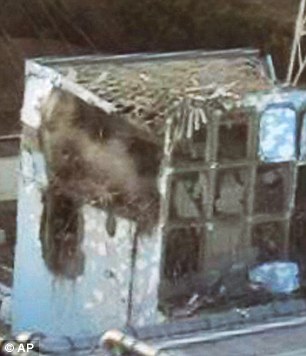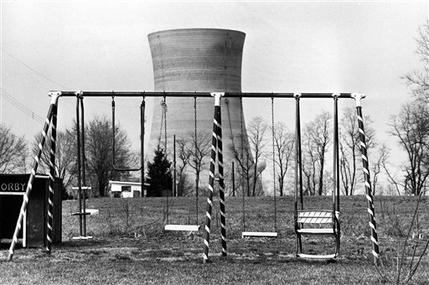|

by Juergen Baetz
April 21, 2011
from
AssociatedPress Website
|
Frank Jordans in
Geneva, Camille Rusticci in Paris, Yu Bing in Beijing,
Jon Fahey in Washington, Jim Heintz in Moscow and Shino
Yuasa in Tokyo
contributed to this
report. |
BERLIN (AP)
From the U.S. to Japan, it's illegal to
drive a car without sufficient insurance, yet governments have
chosen to run the world's 443 nuclear power plants with hardly any
insurance coverage whatsoever.

Japan's Fukushima
Dai-ichi nuclear disaster, which will leave taxpayers there
with a massive bill,
highlights one of the industry's
key weaknesses - that
nuclear power is a viable source for cheap energy only if plants go
uninsured.
The plant's operator,
Tepco, had no disaster insurance.
Governments that use nuclear energy are
torn between the benefit of low-cost electricity and the risk of a
nuclear catastrophe, which could total trillions of dollars and even
bankrupt a country.
The bottom line is that it's a gamble:
Governments are hoping to
dodge a one-time disaster while they accumulate small gains over the
long-term.
Yet in financial terms, nuclear incidents can be so
devastating that the cost of full insurance would be so high as to
make nuclear energy more expensive than fossil fuels.
The cost of a worst-case nuclear accident at a German plant, for
example, has been estimated to total as much as € 7.6 trillion
($11 trillion), while the mandatory reactor insurance is only
€ 2.5 billion ($3.65 billion).
"The € 2.5 billion will be just
enough to buy the stamps for the letters of condolence," said
Olav Hohmeyer, an economist at the University of Flensburg who
is also a member of the German government's environmental
advisory body.
One estimate by a German think tank
shows that coverage for every € 1 trillion ($1.5 trillion) in
estimated damages would theoretically cost annual insurance of
€ 47 billion ($68.5 billion).
A similar situation exists for nuclear plants in the U.S., Japan,
China, France and other countries.

FILE - In this March
30, 1979 file photo,
a cooling tower at
the Three Mile Island nuclear power plant near Harrisburg, Pa.,
looms behind an
abandoned playground. Japan's Fukushima disaster,
which will leave
taxpayers there with a massive bill, brings to the fore one of the
industry's key weaknesses,
that nuclear
power is a viable source for cheap energy only if it goes uninsured.
(AP Photo/Barry
Thumma, file)
It is still unclear what the final cost
will be for the Fukushima Dai-ichi plant,
crippled by Japan's March
11 earthquake and tsunami.
Operator Tepco's shares have been battered, and analysts say Japan -
which already has the highest debt level among the world's
industrialized nations - might eventually have to nationalize the
company and take on its massive liabilities.
"Around the globe, nuclear risks -
be it damages to power plants or the liability risks resulting
from radiation accidents - are covered by the state. The private
insurance industry is barely liable," said Torsten Jeworrek, a
board member at Munich Re, one of the world's biggest
reinsurance companies.
In Switzerland, the obligatory insurance
for nuclear plants is being raised from 1 to 1.8 billion Swiss
francs ($2 billion), but a government agency estimates that a
Chernobyl-style disaster might cost more than 4 trillion francs -
about eight times the country's annual economic output.
A major nuclear accident is statistically extremely unlikely when
human errors, natural disasters or terror attacks are excluded, but
the world has already suffered three in just about thirty years:
Many countries back nuclear energy as a cleaner alternative to
fossil fuels, even though right now there still is no solution for
the permanent disposal of radioactive waste.
Governments could opt for a middle road, taking out more insurance
to protect taxpayers from massive bills, but that would make nuclear
energy cost more. Ultimately, the decision to keep insurance on
nuclear plants to a minimum is a way of supporting the industry.
"Capping the insurance was a clear
decision to provide a non-negligible subsidy to the technology,"
said Klaus Toepfer, a former German environment minister and
longtime head of the U.N. Environment Program (UNEP), said.
The nuclear insurance in Germany costs
utilities € 12 million ($17 million) a year or
€
0.008 cents ($0.015 cents) per kilowatt
hour of electricity, a tiny part of the final energy cost to
customers of about € 0.22 ($0.32 cents).
Increasing the liability coverage to, say, € 100 billion ($146
billion) would lead to a premium of about € 3.20 ($4.67) per
kilowatt hour, according to Bettina Meyer of the Berlin think tank
Green Budget Germany.
China, which is under international pressure to lower its use of
coal and cut its carbon emissions, is betting on nuclear power to
feed its rising energy demand. Yet it has an industry insurance pool
covering damages only up to 300 million Yuan ($46 million) and
another 800 million Yuan from the government to compensate victims,
too little to cover damages in any meaningful way.
The situation is not much better among veteran users of nuclear
energy.
In the U.S., where no new reactors have been planned and completed
since the 1979 Three Mile Island accident, the necessary insurance
for nuclear operators is capped at just $375 million per plant by
law, with further claims funded by the utilities up to a maximum of
$12.6 billion.
France, a country dotted with 58 reactors, only requires an
insurance of € 91 million ($133 million) from plant operators,
with the government guaranteeing liabilities up to € 228 million
($333 million). The figures were similar for Britain, Russia and the
Czech Republic.
Damage estimates for a worst-case nuclear disaster differ widely
because it is difficult to forecast the spillover effects of a
meltdown - death and illness from radiation, compensation for lost
work and the economic impact of massive evacuations for years.
The cost of a nuclear meltdown at the Indian Point reactors, located
24 miles (37 kilometers) north of New York City has been estimated
at up to $416 billion in a study.
But that does not take into full
account the impact on one of the world's great cities.
"A worst-case scenario could lead to
the closure of New York City for years, as happened at
Chernobyl... leading to almost unthinkable costs," University of
Pennsylvania's Howard Kunreuther and Columbia University's
Geoffrey Heal said in their 2009 study.
On Wednesday, following a brief visit to
Ukraine's crippled Chernobyl reactor, U.N. Secretary-General Ban Ki-moon
warned that the,
"unfortunate truth is that we are likely to see more
such disasters."
"To many, nuclear energy looks to be
a relatively clean and logical choice in an era of increasing
resource scarcity. Yet the record requires us to ask painful
questions: have we correctly calculated its risks and costs?"
Ban said.
In Germany, where Chernobyl's radiation
wave blew over in 1986, a 1992 study for the government, the latest
official report available, found the total cost of health damages
and other economic losses by a nuclear disaster could amount to
€ 7.6 trillion ($11.1 trillion) in today's money.
"If you take all external costs into
account, the conclusion is inevitable: Nuclear power is not
economically viable," Hohmeyer said. "The risk is only bearable
if you externalize it on the wider society."
The majority of Germans and its
political parties have concluded that the potential damage outweighs
the benefits, and the country now stands alone among industrialized
nations in its determination to abandon nuclear power.
But Dieter Marx of Germany's Nuclear Forum, an industry lobby, says
no industry has prices that reflect all of its risks, and insists
that the risk of a meltdown was very low.
"Ultimately, it comes down to the
question of how big a risk the society is ready to bear," he
said.
|


